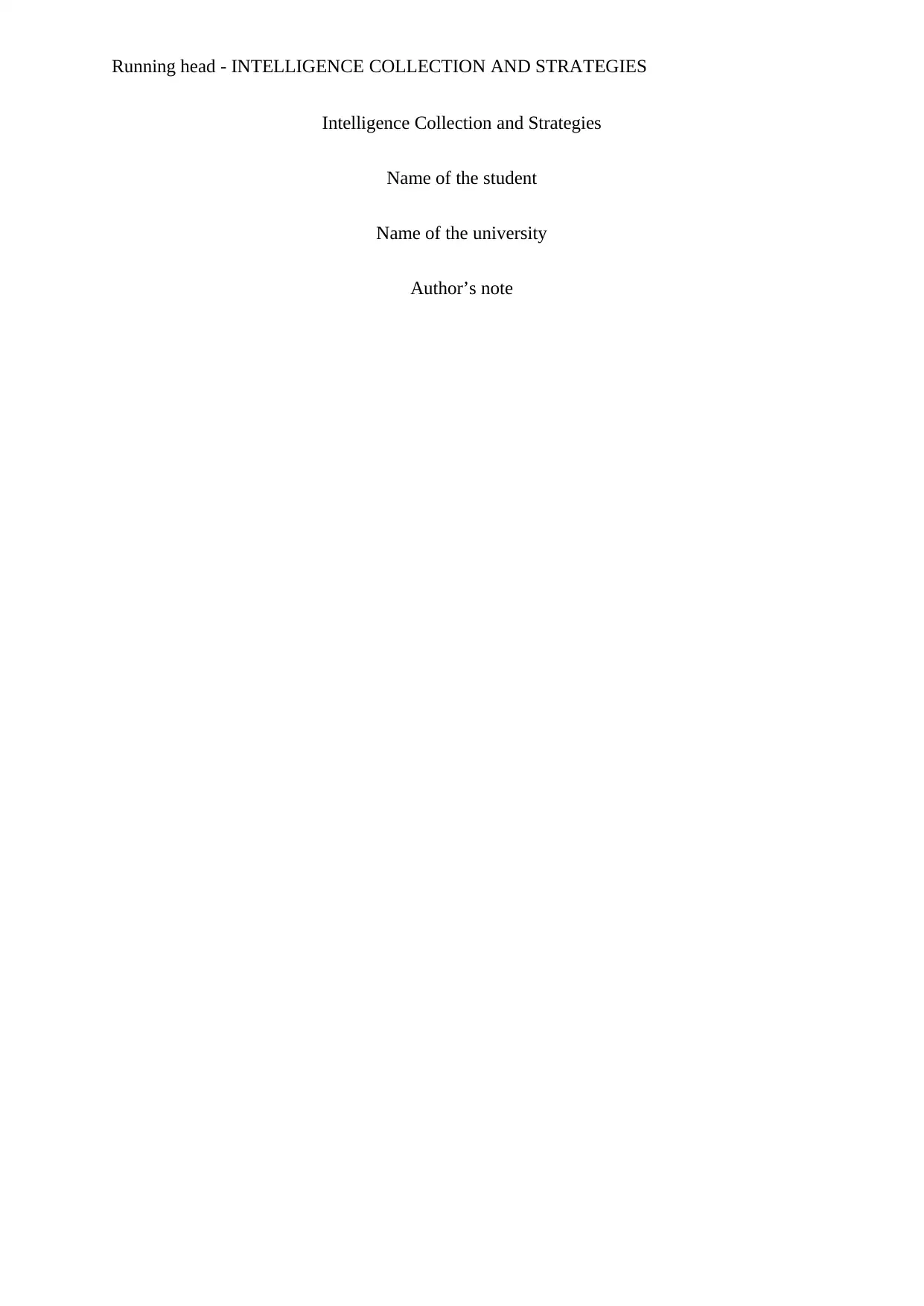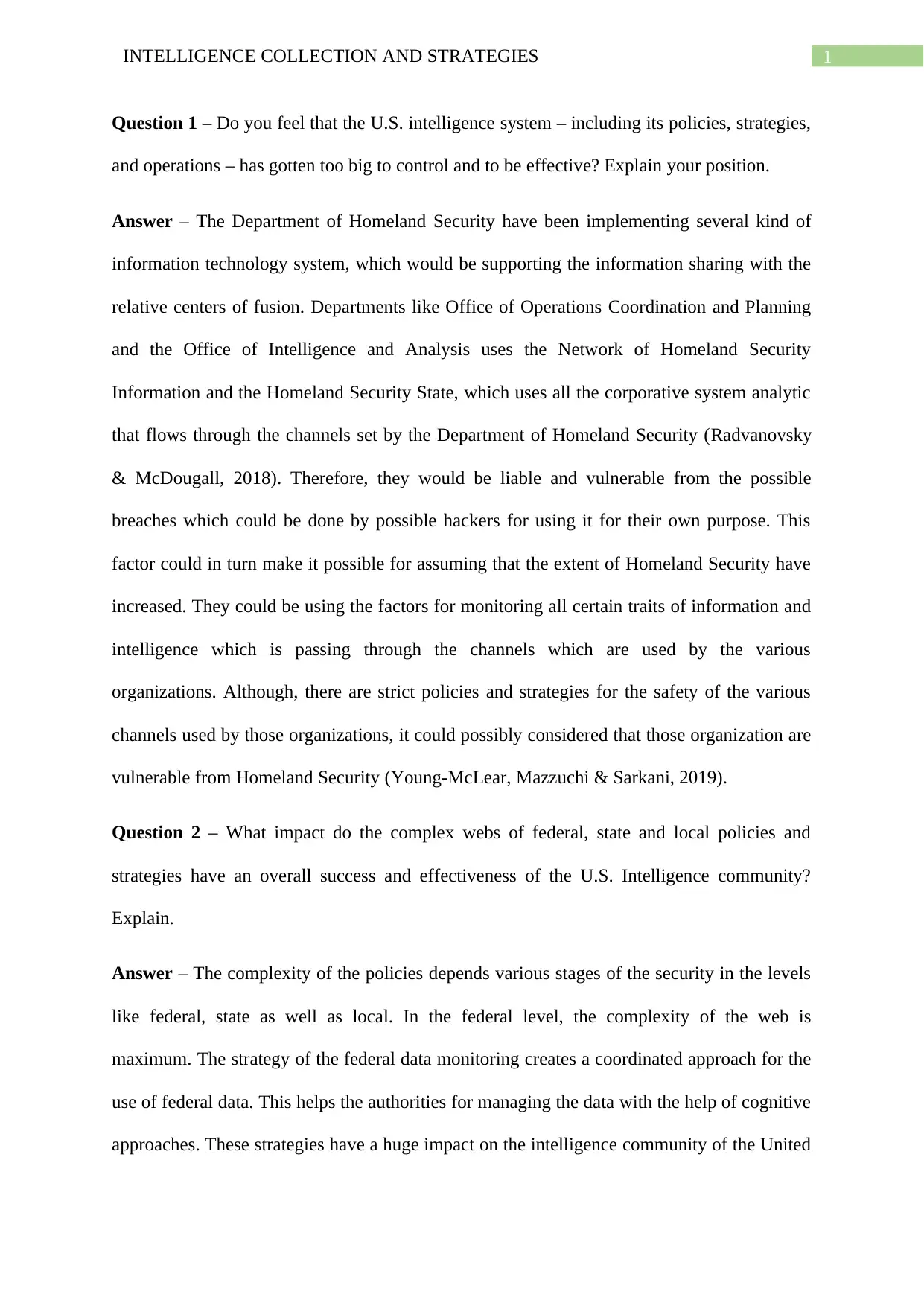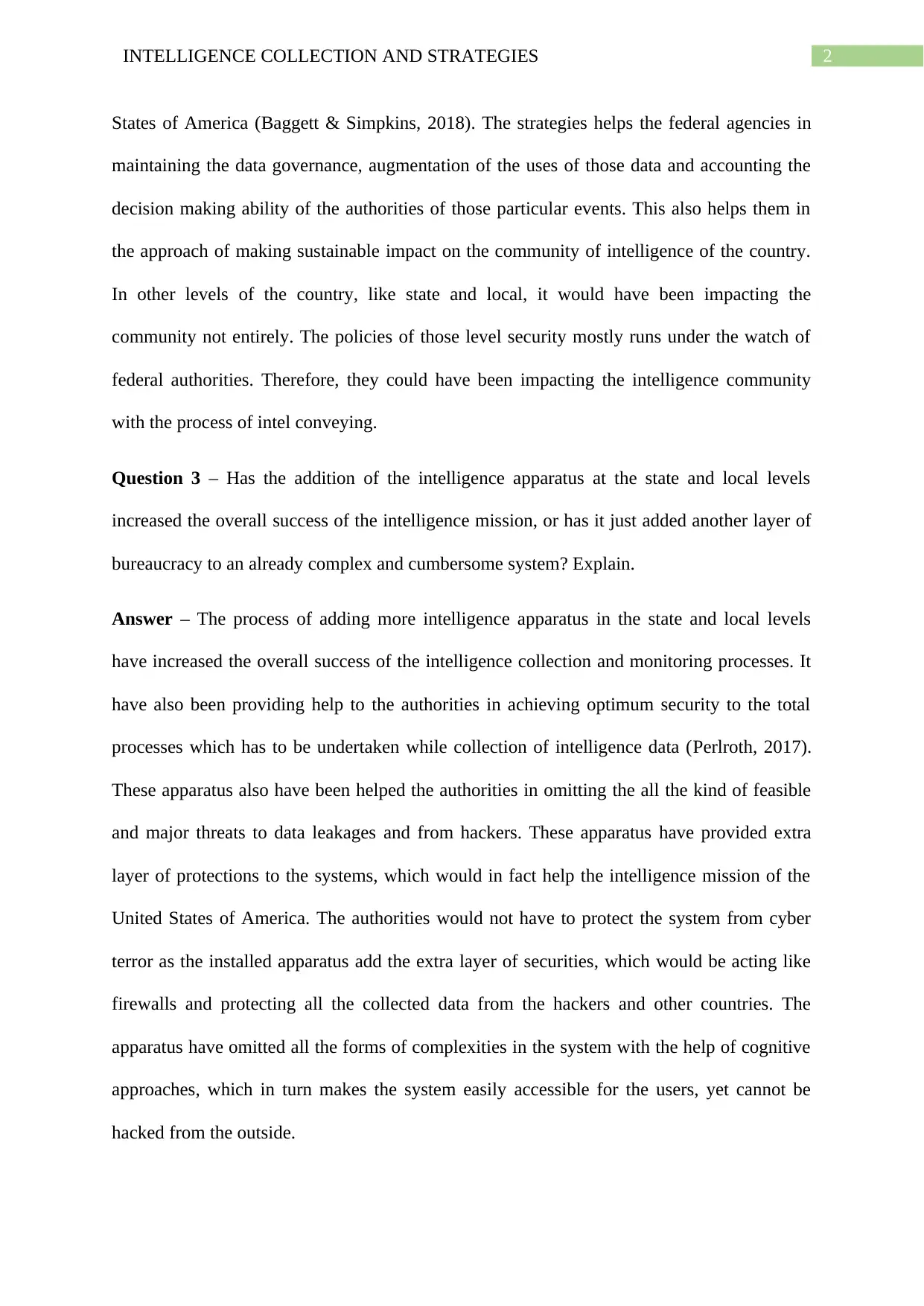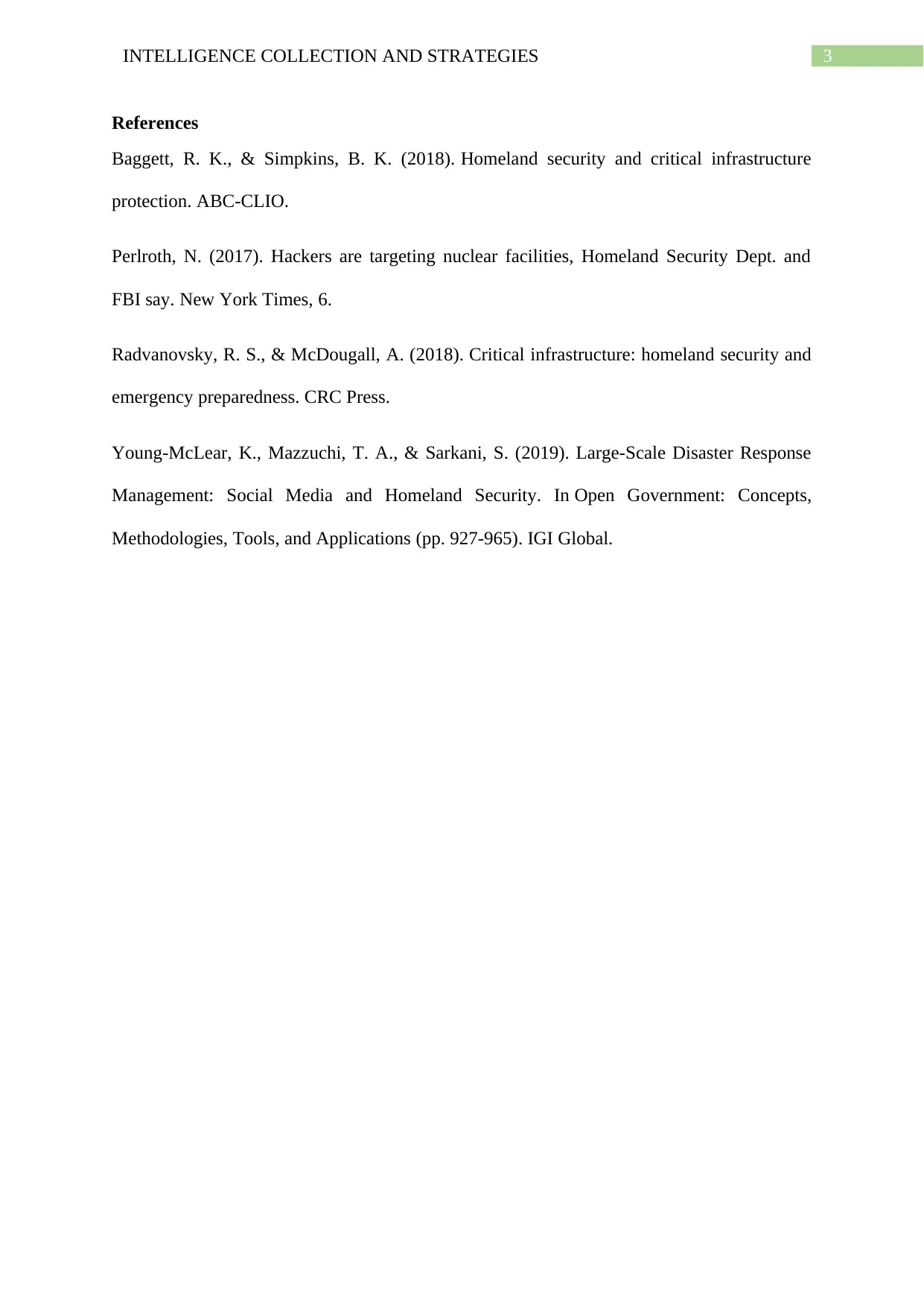Analysis of U.S. Intelligence Collection Strategies and Policies
VerifiedAdded on 2022/12/30
|4
|876
|74
Discussion Board Post
AI Summary
This discussion board post analyzes the U.S. intelligence system, focusing on its policies, strategies, and operations. The student addresses whether the system has become too large to control and effective, exploring the impact of federal, state, and local policies on the U.S. intelligence community. The post examines the role of intelligence apparatus at state and local levels, evaluating whether they enhance the success of intelligence missions or add to bureaucratic complexity. The student references the Department of Homeland Security and fusion centers, highlighting the importance of information sharing and the challenges related to data security and potential vulnerabilities. The post also includes references to supporting literature.

Running head - INTELLIGENCE COLLECTION AND STRATEGIES
Intelligence Collection and Strategies
Name of the student
Name of the university
Author’s note
Intelligence Collection and Strategies
Name of the student
Name of the university
Author’s note
Paraphrase This Document
Need a fresh take? Get an instant paraphrase of this document with our AI Paraphraser

1INTELLIGENCE COLLECTION AND STRATEGIES
Question 1 – Do you feel that the U.S. intelligence system – including its policies, strategies,
and operations – has gotten too big to control and to be effective? Explain your position.
Answer – The Department of Homeland Security have been implementing several kind of
information technology system, which would be supporting the information sharing with the
relative centers of fusion. Departments like Office of Operations Coordination and Planning
and the Office of Intelligence and Analysis uses the Network of Homeland Security
Information and the Homeland Security State, which uses all the corporative system analytic
that flows through the channels set by the Department of Homeland Security (Radvanovsky
& McDougall, 2018). Therefore, they would be liable and vulnerable from the possible
breaches which could be done by possible hackers for using it for their own purpose. This
factor could in turn make it possible for assuming that the extent of Homeland Security have
increased. They could be using the factors for monitoring all certain traits of information and
intelligence which is passing through the channels which are used by the various
organizations. Although, there are strict policies and strategies for the safety of the various
channels used by those organizations, it could possibly considered that those organization are
vulnerable from Homeland Security (Young-McLear, Mazzuchi & Sarkani, 2019).
Question 2 – What impact do the complex webs of federal, state and local policies and
strategies have an overall success and effectiveness of the U.S. Intelligence community?
Explain.
Answer – The complexity of the policies depends various stages of the security in the levels
like federal, state as well as local. In the federal level, the complexity of the web is
maximum. The strategy of the federal data monitoring creates a coordinated approach for the
use of federal data. This helps the authorities for managing the data with the help of cognitive
approaches. These strategies have a huge impact on the intelligence community of the United
Question 1 – Do you feel that the U.S. intelligence system – including its policies, strategies,
and operations – has gotten too big to control and to be effective? Explain your position.
Answer – The Department of Homeland Security have been implementing several kind of
information technology system, which would be supporting the information sharing with the
relative centers of fusion. Departments like Office of Operations Coordination and Planning
and the Office of Intelligence and Analysis uses the Network of Homeland Security
Information and the Homeland Security State, which uses all the corporative system analytic
that flows through the channels set by the Department of Homeland Security (Radvanovsky
& McDougall, 2018). Therefore, they would be liable and vulnerable from the possible
breaches which could be done by possible hackers for using it for their own purpose. This
factor could in turn make it possible for assuming that the extent of Homeland Security have
increased. They could be using the factors for monitoring all certain traits of information and
intelligence which is passing through the channels which are used by the various
organizations. Although, there are strict policies and strategies for the safety of the various
channels used by those organizations, it could possibly considered that those organization are
vulnerable from Homeland Security (Young-McLear, Mazzuchi & Sarkani, 2019).
Question 2 – What impact do the complex webs of federal, state and local policies and
strategies have an overall success and effectiveness of the U.S. Intelligence community?
Explain.
Answer – The complexity of the policies depends various stages of the security in the levels
like federal, state as well as local. In the federal level, the complexity of the web is
maximum. The strategy of the federal data monitoring creates a coordinated approach for the
use of federal data. This helps the authorities for managing the data with the help of cognitive
approaches. These strategies have a huge impact on the intelligence community of the United

2INTELLIGENCE COLLECTION AND STRATEGIES
States of America (Baggett & Simpkins, 2018). The strategies helps the federal agencies in
maintaining the data governance, augmentation of the uses of those data and accounting the
decision making ability of the authorities of those particular events. This also helps them in
the approach of making sustainable impact on the community of intelligence of the country.
In other levels of the country, like state and local, it would have been impacting the
community not entirely. The policies of those level security mostly runs under the watch of
federal authorities. Therefore, they could have been impacting the intelligence community
with the process of intel conveying.
Question 3 – Has the addition of the intelligence apparatus at the state and local levels
increased the overall success of the intelligence mission, or has it just added another layer of
bureaucracy to an already complex and cumbersome system? Explain.
Answer – The process of adding more intelligence apparatus in the state and local levels
have increased the overall success of the intelligence collection and monitoring processes. It
have also been providing help to the authorities in achieving optimum security to the total
processes which has to be undertaken while collection of intelligence data (Perlroth, 2017).
These apparatus also have been helped the authorities in omitting the all the kind of feasible
and major threats to data leakages and from hackers. These apparatus have provided extra
layer of protections to the systems, which would in fact help the intelligence mission of the
United States of America. The authorities would not have to protect the system from cyber
terror as the installed apparatus add the extra layer of securities, which would be acting like
firewalls and protecting all the collected data from the hackers and other countries. The
apparatus have omitted all the forms of complexities in the system with the help of cognitive
approaches, which in turn makes the system easily accessible for the users, yet cannot be
hacked from the outside.
States of America (Baggett & Simpkins, 2018). The strategies helps the federal agencies in
maintaining the data governance, augmentation of the uses of those data and accounting the
decision making ability of the authorities of those particular events. This also helps them in
the approach of making sustainable impact on the community of intelligence of the country.
In other levels of the country, like state and local, it would have been impacting the
community not entirely. The policies of those level security mostly runs under the watch of
federal authorities. Therefore, they could have been impacting the intelligence community
with the process of intel conveying.
Question 3 – Has the addition of the intelligence apparatus at the state and local levels
increased the overall success of the intelligence mission, or has it just added another layer of
bureaucracy to an already complex and cumbersome system? Explain.
Answer – The process of adding more intelligence apparatus in the state and local levels
have increased the overall success of the intelligence collection and monitoring processes. It
have also been providing help to the authorities in achieving optimum security to the total
processes which has to be undertaken while collection of intelligence data (Perlroth, 2017).
These apparatus also have been helped the authorities in omitting the all the kind of feasible
and major threats to data leakages and from hackers. These apparatus have provided extra
layer of protections to the systems, which would in fact help the intelligence mission of the
United States of America. The authorities would not have to protect the system from cyber
terror as the installed apparatus add the extra layer of securities, which would be acting like
firewalls and protecting all the collected data from the hackers and other countries. The
apparatus have omitted all the forms of complexities in the system with the help of cognitive
approaches, which in turn makes the system easily accessible for the users, yet cannot be
hacked from the outside.
⊘ This is a preview!⊘
Do you want full access?
Subscribe today to unlock all pages.

Trusted by 1+ million students worldwide

3INTELLIGENCE COLLECTION AND STRATEGIES
References
Baggett, R. K., & Simpkins, B. K. (2018). Homeland security and critical infrastructure
protection. ABC-CLIO.
Perlroth, N. (2017). Hackers are targeting nuclear facilities, Homeland Security Dept. and
FBI say. New York Times, 6.
Radvanovsky, R. S., & McDougall, A. (2018). Critical infrastructure: homeland security and
emergency preparedness. CRC Press.
Young-McLear, K., Mazzuchi, T. A., & Sarkani, S. (2019). Large-Scale Disaster Response
Management: Social Media and Homeland Security. In Open Government: Concepts,
Methodologies, Tools, and Applications (pp. 927-965). IGI Global.
References
Baggett, R. K., & Simpkins, B. K. (2018). Homeland security and critical infrastructure
protection. ABC-CLIO.
Perlroth, N. (2017). Hackers are targeting nuclear facilities, Homeland Security Dept. and
FBI say. New York Times, 6.
Radvanovsky, R. S., & McDougall, A. (2018). Critical infrastructure: homeland security and
emergency preparedness. CRC Press.
Young-McLear, K., Mazzuchi, T. A., & Sarkani, S. (2019). Large-Scale Disaster Response
Management: Social Media and Homeland Security. In Open Government: Concepts,
Methodologies, Tools, and Applications (pp. 927-965). IGI Global.
1 out of 4
Related Documents
Your All-in-One AI-Powered Toolkit for Academic Success.
+13062052269
info@desklib.com
Available 24*7 on WhatsApp / Email
![[object Object]](/_next/static/media/star-bottom.7253800d.svg)
Unlock your academic potential
Copyright © 2020–2025 A2Z Services. All Rights Reserved. Developed and managed by ZUCOL.





